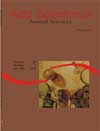<b>Avaliação de diversidade genética em subespécies e cruzamento de avestruzes (<em>Struthio camelus</em>) com o uso de marcadores RAPD</b> - DOI: 10.4025/actascianimsci.v27i2.1222
Resumo
Na estrutiocultura as ligações entre características físicas e desempenho precisam de investigação adicional e as informações sobre diversidade genética são mínimas. Portanto, o presente trabalho representa um importante passo em estudos de genética de avestruzes. Foram coletadas amostras de sangue de 30 animais, machos e fêmeas, das subespécies Blue Neck, African Black e do cruzamento Red Blue (Red Neck X Blue Neck), para extração de DNA. Após amplificação, os produtos foram analisados e interpretados pela técnica RAPD, fornecendo dados de similaridade genética entre os indivíduos com a utilização do coeficiente de Jaccard e dados de distância genética entre as subespécies e diversidade genética dentro de subespécies através do coeficiente de Nei. Os resultados alcançados demonstraram baixa similaridade e alta diversidade genética entre os indivíduos analisados de cada subespécie, porém as distâncias genéticas entre as subespécies não foram significativas, indicando que não houve diferenciação genética entre subespécies. Os valores de diferenciação genética entre a subespécie Blue Neck e o cruzamento Red Blue ficaram próximos da significância, sugerindo uma maior diversidade genética entre elasDownloads
DECLARAÇÃO DE ORIGINALIDADE E DIREITOS AUTORAIS
Declaro que o presente artigo é original, não tendo sido submetido à publicação em qualquer outro periódico nacional ou internacional, quer seja em parte ou em sua totalidade.
Os direitos autorais pertencem exclusivamente aos autores. Os direitos de licenciamento utilizados pelo periódico é a licença Creative Commons Attribution 4.0 (CC BY 4.0): são permitidos o compartilhamento (cópia e distribuição do material em qualqer meio ou formato) e adaptação (remix, transformação e criação de material a partir do conteúdo assim licenciado para quaisquer fins, inclusive comerciais.
Recomenda-se a leitura desse link para maiores informações sobre o tema: fornecimento de créditos e referências de forma correta, entre outros detalhes cruciais para uso adequado do material licenciado.








































